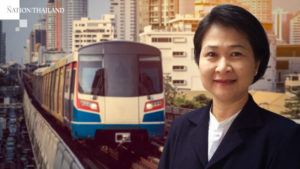
Plan to develop Bangkok’s train transport to reduce energy bill and greenhouse gas
The six mass rapid-transit lines will be developed to reduce energy and greenhouse gas emissions, while a survey found 59 per cent of city commuters don’t use the electric train due to lack of good feeder service.
Wilairat Sirisoponsilp, deputy director-general of the Ministry of Transport’s Office of Transport and Traffic Policy and Planning, revealed the plan on Sunday during a seminar on reducing energy usage in transportation.He said the ministry’s consultant has presented the results of the energy assessment project that can be reduced by following the evaluation of the six mass rapid transit lines currently in service: Green Line (Mo Chit – Samrong); Green Line (Samrong – Samut Prakan); Green Line (National Stadium – Bang Wa); Blue Line (Bang Sue – Hua Lamphong); Suvarnabhumi Airport Rail Link Or Airport Rail Link and Purple Line (Bang Yai – Tao Poon).
By implementation of the project for a period of 12 months, the six mass rapid transit lines in service can help reduce energy consumption by approximately 224.3 kilotonnes of oil equivalent (ktoe).
If they operate on all routes in Bangkok and its vicinity according to the M-Map master plan, it will help reduce energy consumption by approximately 1,375.5ktoe in 2036. By 2020, the six mass rapid transit lines can help reduce greenhouse gas emissions by approximately 0.64 metric tonnes of carbon dioxide equivalent.
Kerati Kijmanawat, logistics and supply chain lecturer at Naresuan University as a deputy project manager, revealed the results of the survey of six electric train service areas and two pre-operating routes, namely Blue Line (Bang Sue – Tha Phra) and Green Line (Mo Chit – Saphan Mai – Khu Khot Section) by surveying 500 samples per route.
Those aged 23-29 and earning Bt15,001-Bt30,000 used the services at least 2-3 times per week in urgent hours, round-trip from errands, and work accounted for 32 per cent.
Those aged less than 22 with income less than Bt15,000 per month use the service every day in urgent hours, and round-trips to school and university accounted for 31 per cent.
The reason for choosing the electric train compared to other public transport is that there is a 63 per cent time saving, 19 per cent easier time management, 8 per cent cost saving, 6 per cent more convenience than other public transportation, and 4 per cent safety, he said.
Of those surveyed, 59 per cent did not reach the destination with one system, or had to travel on multiple systems, 18 per cent found the price high, 7 per cent dislike crowded transportation, 6 per cent found the access poor, 6 per cent found it inconvenient and 4 per cent complained of no feeder service to the electric train.
“The state should have a policy to reduce expenses and organise a secondary transportation system to connect to the train such as buses for convenient transportation. It will help reduce energy consumption and greenhouse gas emissions,” said Kerati.
Source: https://www.nationthailand.com/news/30392706

